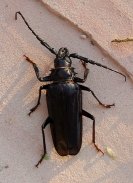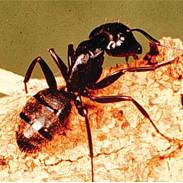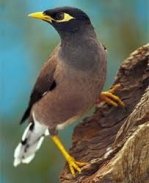



Wood Boring Beetles

WOOD BORING BEETLES
There are many different types of beetles that attack timber at various stages, from when it is a standing tree, until it is dry timber used for building purposes. Three main timber pest borers are mentioned here, and although this will equip a householder with basic knowledge, I recommend that the damage and the insect, if possible, be referred to an authority for identification before any control method is carried out. There are four stages in a beetle lifecycle - egg, larva, pupa and adult. Of these four stages, it is the larva stage that is usually the most destructive, causing most of the boring and eating of wood. The exit holes are made by the emerging adult beetle. The presence of holes does not necessarily indicate that the pests are currently active in the wood.
Pinhole Borer
The pinhole borer, also known as the ambrosia beetle, got its name from the deep and relatively straight holes that it makes in the wood. It attacks only green timber, either while the tree is still standing, or when it is a freshly felled log. The larvae and adults cannot live in dry wood, so once the wood has been dried and sawn, the insects die and are no longer a problem. Holes have no frass and are made at right angles to the grain. The adult beetle bores the hole and the larvae then live deep in this hole. The larvae feed on a fungus that lines the walls of the tunnels and not the wood itself, hence its reliance on moist timber. A black discolouration is often seen at the entrance of the holes, resulting from the fungus.
Furniture Beetle
The furniture beetle attacks mainly pines, particularly timber that has been in service for more than 20 years. Woods attacked include radiata pine, baltic pine, hoop pine and oregon. Some species of pine are resistant, for example white cypress pine. Attack by the furniture beetle mostly occurs in flooring, panelling and furniture. It is seldom found in roofing timbers because of the higher temperatures present in the roof. The adult beetle lays eggs in cracks, crevices and eroded areas of timber. The larvae hatch and feed in the sapwood or heartwood. They feed and pupate in the timber and adults emerge through exit holes. The lifecycle is usually two to three years, but can be longer, depending on the conditions. The presence of furniture beetles in a house adversely affects the resale value of the property and it is important that a certificate is obtained from a pest control firm before you purchase a house.
Powderpost Beetle
Powderpost beetles attack the sapwood of hardwoods such as tallowwood, spotted gum, Sydney blue gum and many other non-pine timbers. Pines are not affected because pines have very small pores at the end of the wood which make it impossible for the female to deposit her eggs in them. The name 'powderpost'is derived from the powder-like frass that the beetle ejects. Powderpost beetles occur mostly in the warm and humid regions of Australia, especially during summer. The larvae feed on starch in the sapwood, so hardwood timbers such as blackbutt, which don't have starch in the sapwood, are not affected by this beetle. Once the sapwood of a timber is infested, it will continue to be reinfested until it is all destroyed.
Female powderpost beetles lay eggs singly, in exposed end pores of the sapwood. Eggs hatch into larvae which feed and pupate in the wood. Adult beetles later emerge through round holes 1-2mm in diameter.
In Queensland and New South Wales, legislation has been introduced to control the sale and use of products containing sapwood susceptible to powderpost beetle. The Acts require that timber for things that require a long life, such as flooring, joinery, furniture, be non-susceptible timber, or treated timber. The Forestry Department in each state may be contacted for more information. Most attacks occur in the first few years of the timber and a person is given 24 months in relation to these two Acts, during which time action can be taken against the timber supplier, builder or retailer. Outside this time period, the Acts do not apply. Structural timbers are allowed up to 25% of the perimeter to be destroyed before the Timber Marketing Act, or other equivalent, is breached.
How do you prevent Wood Boring Beetle infestation :
- Similar to termites, wood boring beetles are drawn to wood. That is where they derive the name from. As the most obvious course of action, use or burn away any wood that is being stored in your house or leaning against the exterior boundaries of your home.
- Close any gaps that has formed on surfaces of the wood that is to be carried home or about to be used for household.
- Keep all the wood dry and moisture-free to avoid attracting the beetles.
- Before buying, inspect all the wood for holes which might be a telltale sign of beetle infestation that wood.
- Paint all your wooden furniture or other articles to limit their exposure and safeguard them from beetles.
- Regularly call in pest control services like R.I.P. Pest Management to schedule inspection of your property for undetected infestation or damage.
Now that your house has already been infested by wood boring beetles, preventative measures become secondary concern. So what to do when there is a full blown infestation of wood boring beetles?
- Most of the times, the adult beetles are pretty harmless. It is the larvae that cause the issue. Once the larvae are inside the wood, there is hardly anything that you can do to get rid of them. The most feasible solution would be to replace all the wood that are infested.
- Treating your wood with borate can help in controlling the beetle larvae to some extent and alleviate maximum damage.
- Avoid spraying DIY pesticide on firewood as it might lead to health hazard when combusted.
- Bring out all important stuffs from sheds and barns as they are the most vulnerable places for infestation.
- Maximise the usage of sanded and varnished wood as they are mostly resistant to the wood boring beetles.













